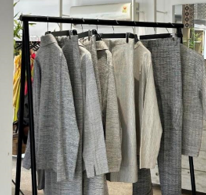
By Akuvi ADJABS
Sustainability has emerged as a moral gold standard in the current climate crisis, necessitating nothing less than a revolution.
That urgency is most apparent in the fashion industry, which has been long criticised for its environmental and ethical violations.
However, the sustainable fashion movement is gaining momentum, and it is becoming evident that some of its most potent weapons are not innovations or policies, but meticulously curated half-truths.
Concealed beneath the eco-conscious branding and ethical rhetoric is a more subdued narrative: the sustainable fashion industry frequently lies. Or at the very least, it distorts the truth until it breaks.
The Green Halo effect
It is an admirable cause. All of the intentions are genuine. However, facts alone rarely generate headlines in a world that is oversaturated with media. Both advocacy organisations and brands are aware of this. Increasingly, exaggeration is employed as a strategy—if not strictly necessary.
Sometimes, sustainability advocates resort to dramatised statistics, overblown claims and fear-driven rhetoric in order to attract funding, influence public opinion or make consumers experience the consequences of their decisions.
The goal justifies the means, or so the theory goes. Saving the planet serves as a moral shield, enabling dubious communication to be presented as “awareness”.
When numbers lie
Consider, for instance, the controversial assertion that the fashion industry is “the second most polluting industry in the world”. Even significant organisations have quoted this statistic, which has been repeated across platforms, including documentaries and brand campaigns.
The statement has become a form of urban legend in the sustainable fashion community, as it has been repeated so frequently that it is now considered fact, despite the absence of any verified global data to substantiate it.
Linda Greer, an environmental scientist who conducted research in China around 2012, is believed to be the source of the confusion. Her research indicated that the textile industry was the second-largest industrial polluter in China, as determined by effluent discharge and chemical use.
However, that discovery was restricted to a specific region and was never intended to be globalised. Her research was misquoted, taken out of context and transformed into a broad, globally applicable statement at some point.
This is the mechanism by which misinformation propagates in advocacy work: a legitimate study is transformed into a fiction due to its urgency, shock and ease of recall. It is not the case that fashion is not a polluter; it is.
Significantly, it contributes to microplastic pollution, carbon emissions and water waste. However, categorising it as the “second worst” in the world is not only inaccurate, but also careless and undermines the credibility of the movement that is striving to effect change.
Case study: Green is the new PR
This has been recognised by brands. A halo of moral superiority is effective in boosting sales, and sustainability is a selling point. While the majority of its business model is based on rapid fashion, a company may advertise a “100 percent sustainable collection”.
Some organisations report emissions reductions without acknowledging that they altered the methodology for calculating those emissions. Other individuals emphasise the term “recycled materials” without recognising that only 5 percent of the product meets the criteria.
Frequently, sustainability reports, which are intended to serve as instruments of transparency, are transformed into glossy publications that contain selective truths.
They are distinguished by significant advancements and ambitious objectives; and they seldom involve setbacks or untenable metrics. “Moving toward”, “exploring” and “committed to” are all examples of meticulously formed language. The phrase appears to be progressive. There is frequently no significance to it.
Is exaggeration even necessary?
What is the uncomfortable question? Is any of this necessary?
There are those who contend that in a society that is preoccupied with convenience and profit, a small amount of dramatisation is the sole effective method of piercing the clutter.
There is a genuine sense of urgency; consumers are overloaded and brands are fiercely competitive. Would anyone even stop to listen in the absence of audacious claims and eye-catching figures? This perspective, however, overestimates the importance of fear-based storytelling and underestimates the public.
It is based on the assumption that individuals will not be motivated to make changes if distortion is not present. However, individuals are becoming more sceptic of perfection and more receptive to nuance, complexity and honest communication.

We do not require the fashion industry to assert that it is saving the world at large. We require it to acknowledge its shortcomings and demonstrate genuine progress, rather than seeking perfection in appearance. Which is more motivating: a brand that declares itself “100 percent sustainable” or one that states “we are 30 percent of the way there, and here is how we are improving…”.
However, exaggeration is frequently employed as a shortcut to creativity. The more challenging and significant route involves radical transparency, engagement and education. Presenting the entire narrative, rather than merely the most noteworthy aspects, may be the key to ensuring that the movement is sustained.
Helpful lies or harmful?
In fairness, these exaggerations occasionally generate outcomes. They inspire public interest, exert pressure on governments and compel consumers to take action. However, at what expense? The backlash can be severe when the truth ultimately emerges, as it always does. Consumers experience a sense of deception. Credibility diminishes for movements.
Silence is the refuge of brands. While exaggeration may garner attention, it is seldom a reliable source of trust.
This is a fatal contradiction in a movement that is founded on principles of accountability and transparency. Even worse, it obscures the distinction between genuine ambition and greenwashing.
Some brands that are legitimately striving to improve are grouped with the bad actors. Consumers frequently become disengaged due to confusion and mistrust.
Can the movement clean up its act?
No, sustainable fashion does not require perfection. However, it is still necessary to be forthright. Advocates who rely on manipulated narratives and questionable numbers will not endure long-term scrutiny.
Greater transparency is necessary for the future: third-party certifications, open-source data and more precise definitions of the term “sustainable”.
It is imperative that movements cease their pursuit of shock value and instead focus on increasing trust. Consumers are more intelligent than they are often acknowledged, and they are becoming more and more sceptical of green haloes that emit excessive light.
If sustainability is to transcend mere trendiness and become a transformation, it must be founded on reality. No, the planet does not require flawless champions.
Honest individuals are required. In the end, even the most environmentally friendly lie remains a falsehood.
>>>the writer is a sustainable fashion writer and a researcher.
The post The Green Lie: How exaggeration fuels – and fools – the sustainable fashion movement appeared first on The Business & Financial Times.
Read Full Story




















Facebook
Twitter
Pinterest
Instagram
Google+
YouTube
LinkedIn
RSS